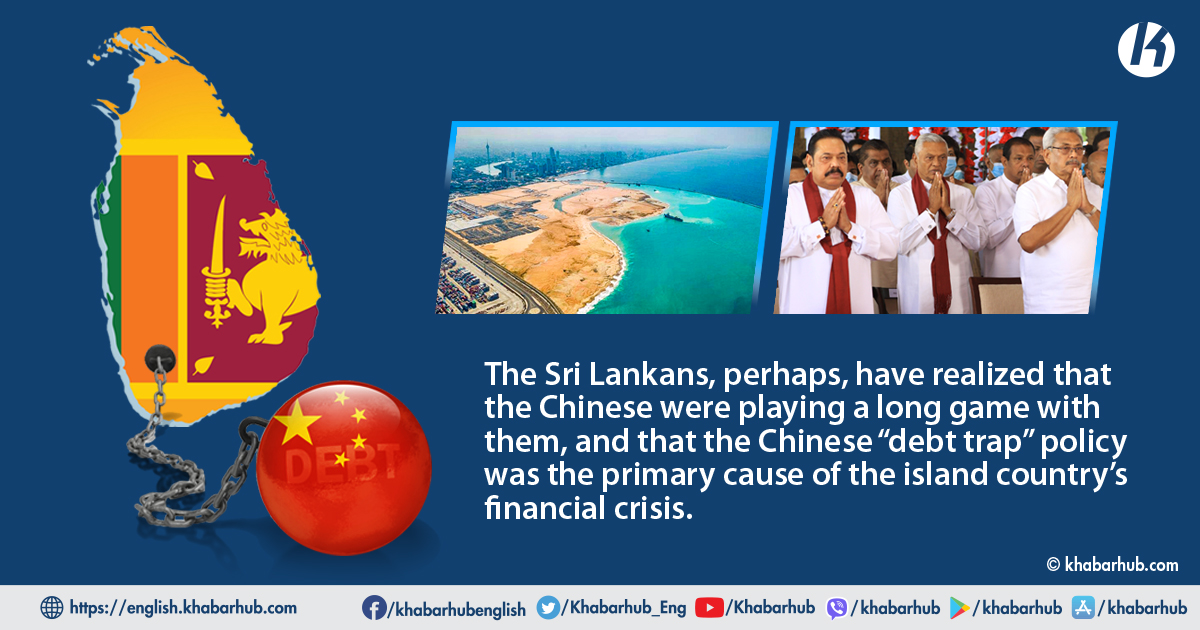KATHMANDU: If a report of the Global Strat View, a Washington-based organization, is to be considered, Sri Lanka has fallen into debt owing to public investment projects sponsored by China as part of its Belt and Road Initiative (BRI).
China disbursed billions of dollars in soft loans to Sri Lanka to become the island country’s fourth-largest lender.
The Global Strat View, citing the example of the Hambantota project, said that the “port developed with significant Chinese funding had no commercial viability, but China persuaded Sri Lanka to proceed with the project.”
And since the port struggled to gain momentum, China wanted it as collateral, therefore compelling the Lankan government to hand over management to a Chinese corporation on a 99-year lease in 2017, according to the report.
Notwithstanding this, Sri Lanka also awarded a contract to China Harbour Engineering Company to build Colombo’s eastern cargo terminal.
Therefore, the Washington-based organization has said that Sri Lanka has to rethink seriously to save its economy, which observers say has fallen into China’s debt-trap policy.
Lanka’s current financial crisis is leading to a humanitarian crisis that could ultimately push the country into bankruptcy, the report stated.
Moreover, the island country owes China more than the US $5 billion in debt and even received an additional loan of US$1 billion last year to help it recover from its financial crisis.
Critics, too, have to say that the Chinese debt trap policy is the primary cause of Sri Lanka’s financial crisis as inflation reaches new highs.
The Sri Lankan government in August last year declared a national economic emergency after a sharp fall in its currency.
The country’s foreign debt increased since 2014, reaching 41.3 percent of GDP in 2019, and this, in turn, has “put a severe load on the country’s debt service”, the report said.
The country’s foreign reserves are depleting faster and stand around USD 1.6 billion, which means that it will be barely enough for a few weeks of imports.
The country has also foreign debt obligations exceeding USD 7 billion in 2022, including repayment of bonds worth USD 500 million in January and USD 1 billion in July 2022.
According to the country’s Central Bank, prices have increased dramatically, with the inflation rate rising to 12.1 percent at the end of December from 9.9 percent in November 2021.
Likewise, during the period, food inflation soared to almost 22 percent.
China disbursed billions of dollars in soft loans to Sri Lanka becoming the country’s fourth-largest lender.
The other two money lenders are the Asian Development Bank, and Japan.
However, since the Rajapaksa government’s efforts to inch too close to Beijing, Sri Lankan interests have been harmed.
Observers have to note that the decline in foreign reserves in part to infrastructure projects financed with Chinese loans have not been profitable as China’s presence there is for its own benefit rather than Sri Lanka’s.
According to the Center for Global Development, other countries like Kyrgyzstan, Laos, Djibouti, the Maldives, Montenegro, Mongolia, Pakistan, and Tajikistan, too, are highly vulnerable to debt distress due to China’s BRI.
One among several examples of a debt trap is the Hambantota Port. Even though the Port had no commercial viability, China persuaded Colombo to proceed with the project.
Sri Lanka, therefore, fell into China’s trap when it was compelled to sacrifice the Hambantota port.
The United States and even India have criticized Chinese projects in Sri Lanka as part of the debt trap policy.
Meanwhile, another large development project financed by the Chinese is Lanka’s second international airport, Mattala International Airport. It is also known as the “World’s Emptiest Airport.”
Moreover, the island country owes China more than the US $5 billion in debt and even received an additional loan of US$1 billion last year to help it recover from its financial crisis.
Therefore, it is surprising that China tries to gift wrap its ulterior motives in benign outreach to unsuspecting partners.
According to the Center for Global Development, other countries like Kyrgyzstan, Laos, Djibouti, the Maldives, Montenegro, Mongolia, Pakistan, and Tajikistan, too, are highly vulnerable to debt distress due to China’s BRI.
Sad stories and glaring examples of debt trap have also emerged from the countries where China has made economic inroads.
(Sources: Global Strat View, ANI, Ceylon Today)









Comment